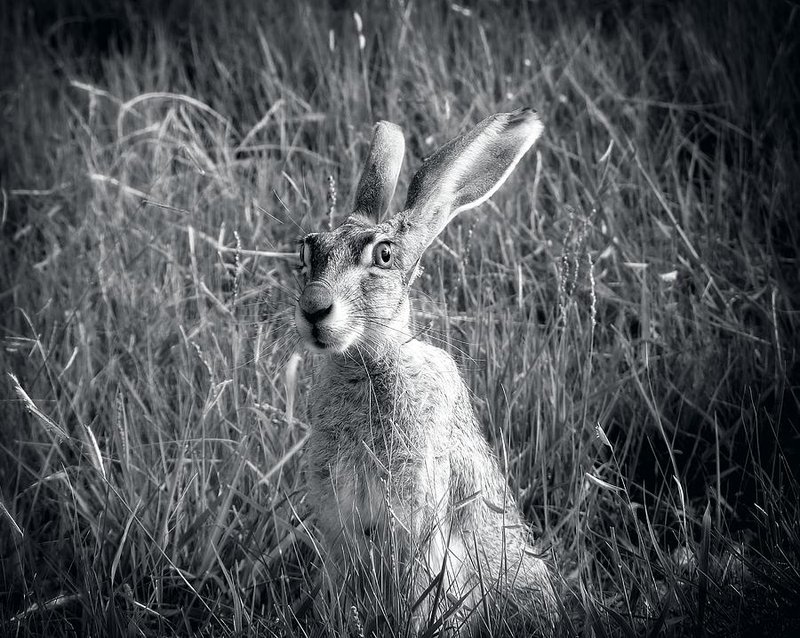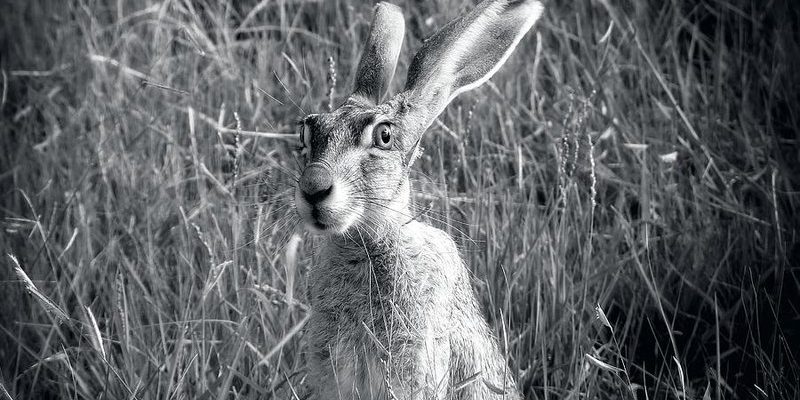
Think of the jackrabbit as a little acrobat of the animal world. With its long ears, powerful legs, and swift movements, this incredible creature offers a glimpse into the diverse world of wildlife. Jackrabbits are not actually rabbits but belong to a family called Leporidae. They are primarily found across North America and come with distinct characteristics that set them apart from their fluffy relatives. You might picture them bounding along the desert landscape or darting through fields, showcasing their impressive speed.
Imagine a small animal that can leap over obstacles and sprint away from potential predators. That’s the jackrabbit in action! These fascinating creatures are well-adapted to their environments, with their long ears helping to regulate body temperature while listening for dangers nearby. For animal lovers or anyone interested in wildlife, the jackrabbit is a captivating topic that beckons deeper exploration.
Physical Characteristics
Jackrabbits are known for their distinctive features that help them thrive in their habitats. They typically grow between 18 to 30 inches long, including their tail. The weight can range from 3 to 9 pounds, depending on the species and habitat. Their most notable characteristics are their exceptionally long ears, which can be up to 5 inches long! These ears are not just for show; they serve a vital purpose. By picking up sounds of predators or other environmental cues, they provide jackrabbits with an edge in survival.
Another striking feature is their powerful hind legs. Jackrabbits can leap over 10 feet in a single bound, which comes in handy when they need to escape from predators. The back feet are adapted for speed and agility, allowing them to change direction quickly when being chased. This remarkable agility is paired with a coat that can blend into their surroundings, aiding in camouflage against potential threats.
Habitat and Distribution
Jackrabbits thrive in a variety of habitats, from deserts to grasslands. These adaptable creatures are widespread across much of North America, particularly in the western United States and parts of Mexico. They prefer open areas where they can run and hide within the brush or tall grasses. This environment allows them to evade predators while also providing ample vegetation to nibble on.
You might think of jackrabbits as desert-dwellers, but they can also be found in regions with varied terrain. They make their homes in burrows or under shrubs, which serve as safe havens from threats. When it comes to having a place to call home, they choose areas with plenty of food sources, like grasses and wildflowers, to keep their energy levels high for those thrilling bursts of speed.
Diet and Feeding Habits
Jackrabbits are herbivores, primarily feeding on a range of plants. Their diet includes grasses, leaves, and even the bark of certain shrubs. Interestingly, they have a unique feeding strategy known as “coprophagy.” This means that jackrabbits consume their own feces to extract more nutrients from their food. It’s a smart survival tactic that allows them to maximize their energy intake.
Feeding often takes place during the cooler hours of the day, either in the early morning or late evening. You might find them munching away under the soft glow of dusk, their ears perked up for any signs of danger. They have to be cautious, though, as owls, coyotes, and other predators are always on the lookout for a meal.
Reproduction and Life Cycle
The reproductive habits of jackrabbits are fascinating and can seem a bit surprising. Female jackrabbits can give birth to several litters each year, with each litter consisting of about 2 to 4 young, known as “kits.” These kits are born fully furred and can see almost immediately after birth, a rarity in the animal kingdom. This adaptability ensures they can quickly become independent and safer from predators.
The gestation period lasts around 40 to 47 days. Once the kits are born, the mother tends to leave them hidden in their nest while she goes off to feed. This strategy, while risky, allows her to protect them from the clutches of predators. As the kits grow, they start to venture out, practicing their hopping skills and learning to navigate their surroundings.
| Characteristic | Details |
| Size | 18 to 30 inches long |
| Weight | 3 to 9 pounds |
| Habitat | Deserts, grasslands, and open fields |
| Diet | Herbivore – grasses, leaves, shrubs |
| Speed | Can leap over 10 feet in one bound |
| Lifespan | 1 to 5 years in the wild |
Predators and Threats
Life as a jackrabbit is not without its challenges. These nimble creatures face various predators, including hawks, eagles, coyotes, and bobcats. Their natural defenses are primarily based on their speed and agility, which allows them to evade most dangers. But even the fastest athletes face challenges. When cornered, a jackrabbit can make sharp turns and sudden jumps, using every ounce of their energy to escape.
Even though they are well-adapted to flee from predators, jackrabbits also face threats from habitat loss and environmental changes. Urbanization and agriculture can reduce their natural habitats, making survival increasingly difficult. Conservation efforts are crucial to maintaining healthy populations and ensuring they thrive in their ecosystems.
Jackrabbit Behavior
Jackrabbits are primarily nocturnal, meaning they are most active at dawn and dusk. During these twilight hours, they forage for food, socialize, and engage in playful behaviors. It’s not unusual to catch a glimpse of them thumping their powerful legs against the ground—a communication method that alerts other jackrabbits of impending danger. This thumping can serve as both a warning and a way to establish territory.
They’re social animals and often form loose groups, especially when food is abundant. While they can be friendly, they also establish hierarchy within their groups, with some individuals asserting dominance over others. Watching a group of jackrabbits interact can reveal much about their personalities and social structures.
Interesting Facts About Jackrabbits
Here’s where things get fun! Did you know that jackrabbits can run at speeds of up to 40 miles per hour? That’s as fast as a speeding car in some neighborhoods! They are also capable of outsmarting their predators by using zig-zag movements, making it tough for hunters to keep up.
Another interesting tidbit is that jackrabbits are often mistaken for hares. The key difference is that hares are larger, have longer legs, and stay hidden in nests, while jackrabbits typically stay out in the open. You might have even seen a jackrabbit on a hike or a camping trip without realizing it!
Conservation Status
While jackrabbits are not currently endangered, certain species are facing threats due to habitat loss and environmental changes. Conservationists are working to monitor populations and ensure that these agile creatures continue to thrive. Maintaining healthy ecosystems where jackrabbits can flourish is essential, and it often involves protecting their habitats and mitigating human impacts.
Being aware of how our actions affect wildlife can make a significant difference. By advocating for environmental awareness and conservation efforts, we can help ensure that jackrabbits and many other species remain part of our natural world. After all, who wouldn’t want to see these agile acrobats grace the landscape for generations to come?
FAQ
What is the difference between a jackrabbit and a regular rabbit?
Jackrabbits are actually not rabbits at all, but rather hares. One key difference is that jackrabbits have longer ears and longer legs than typical rabbits. They also usually have a faster sprint speed and are more adapted to open environments. While rabbits tend to dig burrows, jackrabbits will create simple nests on the ground for their young.
How fast can a jackrabbit run?
Jackrabbits are incredibly fast animals, capable of reaching speeds up to 40 miles per hour. This remarkable speed helps them escape predators, ensuring their survival in the wild. Additionally, jackrabbits use zig-zag movements during their escape, making it even more challenging for predators to catch them.
What do jackrabbits eat?
Jackrabbits are herbivores, primarily consuming grasses, leaves, and shrubs. They are known for their unique feeding habits, including “coprophagy,” where they eat their own feces to extract more nutrients from their food. This practice helps them get the energy they need to sustain their active lifestyles.
Where do jackrabbits live?
Jackrabbits inhabit a variety of environments, including deserts, grasslands, and open fields throughout North America. They prefer areas with ample vegetation, which allows them to forage for food while also providing cover from potential predators. Their adaptability helps them thrive in diverse habitats.
How long do jackrabbits live?
In the wild, jackrabbits typically have a lifespan of 1 to 5 years, depending on various factors such as predation, habitat quality, and food availability. In controlled environments, such as zoos or wildlife sanctuaries, they may live longer due to the absence of natural threats.
Are jackrabbits social animals?
Yes, jackrabbits can be social creatures. They often form loose groups, especially in areas where food sources are abundant. Within these groups, they establish hierarchies and communicate through various behaviors, such as thumping their hind legs to warn of danger. However, they can also be solitary at times, depending on their environment.
How do jackrabbits reproduce?
Jackrabbits have a fascinating reproductive strategy. Females can give birth to several litters each year, with each litter containing about 2 to 4 young, called kits. The kits are born fully furred and can see almost immediately, allowing them to become independent quickly. This rapid growth helps ensure their survival against predators.
What are the main predators of jackrabbits?
Jackrabbits face threats from various predators, including hawks, eagles, bobcats, and coyotes. Their primary defense mechanism is their speed and agility, enabling them to escape from these potential dangers. With the ability to sprint quickly and change directions, jackrabbits have evolved to survive in a world filled with threats.
Why are jackrabbits important to their ecosystems?
Jackrabbits play an essential role in their ecosystems as herbivores. They help control plant growth by feeding on grasses and shrubs, which can promote biodiversity in their habitats. Additionally, they serve as prey for numerous predators, thus helping to maintain the balance of the food web. Their presence is vital for the health of their ecological communities.
Can jackrabbits be kept as pets?
While jackrabbits may seem adorable, they are best suited for life in the wild rather than as pets. They require specific diets and large spaces to roam, as well as mental stimulation to keep them happy. If you’re looking for a pet, consider domesticated rabbits or other animals that are better adapted to living with humans.
How can we help conserve jackrabbit populations?
Conserving jackrabbit populations requires awareness and action. Supporting habitat conservation efforts, advocating for environmental protection, and educating others about the importance of wildlife can all contribute to jackrabbit preservation. Every action counts, and by being mindful of our impact on the environment, we can help ensure that future generations can enjoy the beauty of jackrabbits in their natural habitat.

